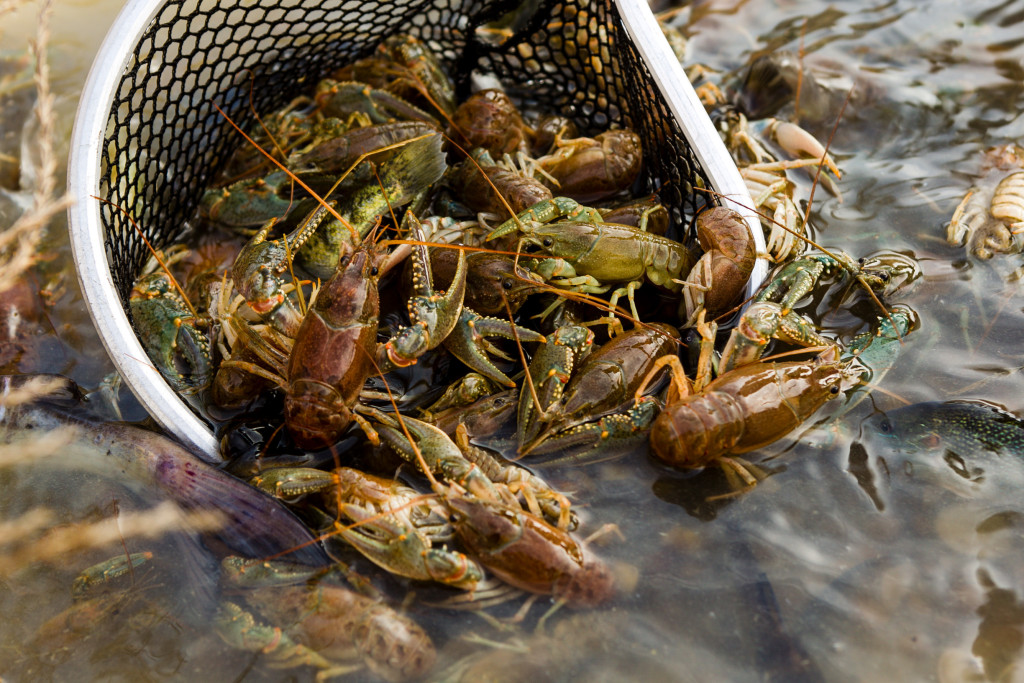
By Grace Gaard
Crayfish – also known as crawdad, crawfish and mudbug – is no fish. It’s an arthropod and more specifically, a freshwater crustacean. With their jointed legs and protective exoskeleton, crayfish are a unique part of Nebraska’s aquatic ecosystems.
A crayfish’s body is comprised of three main parts: head, thorax and abdomen – similar to their distant insect relatives. Where crayfish begin to differ from insects, however, is that they have five pairs of legs, giving them a total of 10, whereas insects only have six legs. This is why crayfish are categorized as decapods – “deca” means 10. Gills for breathing underwater are hidden beneath the thorax, and five pairs of small pleopod legs underneath the tail helps it swim. On females, the pleopods are also where eggs attach and hatch.
Young crayfish emerge from their eggs looking like miniature versions of their parents. As they grow, they shed old exoskeletons, which give them more room for growth. Sometimes, crayfish will even eat their shed skin for calcium, which helps new exoskeleton come back stronger. Crayfish must be careful, though, as periods of shedding make them vulnerable to predators. New exoskeleton is soft, and until it has time to harden, individuals must be careful to avoid exposure.
Habitat
Crawfish have specialized gills that enable them to breathe normal air. As long as they can keep their gills moist, a crayfish can survive 5-7 days outside water. In humid or marshy conditions, crayfish can survive for months. Many crayfish species are burrowers, meaning that they will dig underground and use groundwater to survive, especially in places where there are no aboveground water sources. While several crayfish species prefer to remain underground for the majority of their lives, others will only head beneath the soil when forced to do so.
Habitats such as streams, creeks, soggy ditches and wet meadows are all ideal for crayfish, and some have even been found in grasslands. If you ever find yourself visiting one of these places in Nebraska, you are likely visiting the home of a crayfish. And despite their scary-looking claws, crayfish are generally shy animals that prefer to stay hidden beneath rocks and logs, especially if humans are stomping about.
When a crayfish is alarmed, it will rapidly flip its tail segments back and forth to shoot itself through the water and away from danger. They might even release an odor to signal danger to other crayfish nearby. If you do manage to catch one, however, don’t be offended if you receive a curt pinch, which can be painful enough to elicit a “yeow!”
Food
Aquatic and terrestrial systems are rich in organic matter, called detritus, and these small bits of plant and animal material that collect over time is what crayfish eat, along with a smorgasbord of algae, snails, fish eggs, small fish and other invertebrates.

As prey, many other living things find crayfish to be delectable: other crayfish, river otters, great blue herons, raccoons, large fish and mink, to name a few. Even humans around the world love to eat crayfish. In the southern United States, people in places like Louisiana and Texas often prepare “crawfish boils.” The meat tastes like a cross between lobster and shrimp.
Crayfish are a unique member of Nebraska’s ecosystems. Next time you head outside, be sure to look for one of Nebraska’s five native species of crayfish, including the devil, calico, ringed, northern and prairie crayfish.
